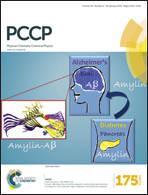Enhanced photocatalytic performance of an Ag3PO4 photocatalyst via fullerene modification: first-principles study
Abstract
The coupling of carbon nanomaterials with semiconductor photocatalysts is a promising route to improve their photocatalytic performance. Herein, density functional theory was used to investigate the electronic structure, charge transfer, photocatalytic activity, and stability in a series of hybrid fullerene (C20, Li@C20, C26, Li@C26)/Ag3PO4(100) composites. When a Li atom is incorporated in fullerene, the adsorption energies significantly increase, although the change of interface distance is negligibly small due to the weak interface interaction. The charge transfer between constituents decreases with the C atom number of fullerene. Compared to pure Ag3PO4, the band gap of the composites is smaller, which enhances the visible-light absorption and photoinduced electron transfer. Most importantly, a type-II, staggered band alignment could be obtained in the C26–Ag3PO4(Li@C26–Ag3PO4) interface, leading to significantly reduced charge recombination and thus enhanced photocatalytic activity. These results reveal that fullerene modification would be an effective strategy to improve the photocatalytic performance of Ag3PO4 semiconductor photocatalysts.



 Please wait while we load your content...
Please wait while we load your content...